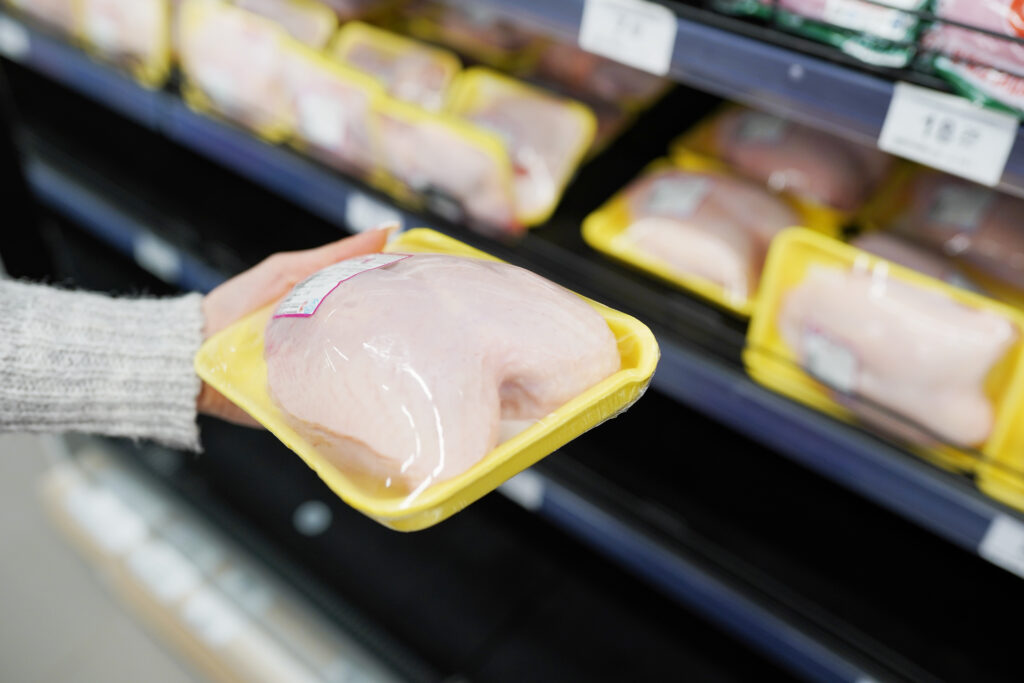
From the Editor: Navigating a chicken pricing controversy
Brett Ruffell
FeaturesB.C. chicken pricing controversy sparks debate, as the industry seeks a nuanced understanding amid its 10 per cent hike proposal.
 Woman choosing packed chicken meat in supermarket. Photo Credit: Adobe Stock
Woman choosing packed chicken meat in supermarket. Photo Credit: Adobe Stock The B.C. chicken industry has been thrust into a pricing controversy, drawing national attention. While mainstream media largely aligns with critics of the proposed 10 per cent price hike, I thought it was essential to delve into the chicken industry’s perspective. The ongoing debate surrounding potential chicken price hike in the province has prompted the B.C. Chicken Marketing Board to advocate for a nuanced examination of its pricing model.
Woody Siemens, the executive director of the B.C. Chicken Marketing Board, provided me with valuable insights into the intricacies surrounding the proposed price adjustments and addressed concerns about the industry’s efforts to lower input costs. He acknowledges the historical reliance on Ontario’s pricing model and the need for a shift due to the unique challenges faced by B.C.’s chicken producers, particularly concerning the cost of feed grain.
Siemens emphasizes the importance of addressing B.C.’s high production costs, driven by factors such as feed grain differentials and land expenses. “We recognize that B.C. is a high-cost production province, and our current pricing model does not adequately cover the expenses incurred by growers. If growers can’t recover their costs, they won’t be able to stay in business long term,” he explains.
In response to criticism from Restaurants Canada and other industry stakeholders, Siemens clarifies that the B.C. Chicken Marketing Board regulates prices only up to the farm gate, focusing on ensuring fair compensation for farmers. Acknowledging the concerns critics have raised, the chicken industry expert states, “We did engage in wide and vigorous consultation, including hatcheries, the hatching commission, processors, all under the Farm Industry Review Board supervisory review.”
He addresses the question about the industry’s efforts to lower input costs, acknowledging ongoing attempts between growers, feed mills, and nutritionists. He says, “There’s been ongoing efforts to optimize and control costs, especially considering the challenges we face in B.C. with feed grain differentials.” Emphasizing the limitations, Siemens notes, “While attempts to explore alternative solutions, such as adjusting feed compositions, have been made, inherent constraints exist due to limited accessibility to certain feed markets, unlike our counterparts in Ontario.”
Additionally, Siemens shed light on the transparency of the B.C. Chicken Marketing Board’s pricing proposal. He says, “Our pricing proposal, based on the cost of production up to the farm gate, is fully transparent to all stakeholders and the public. The same level of transparency cannot be stated by the rest of the value chain from primary processors, further processors, distributors, restaurants, retailers, and others who all can add in unknown levels of cost and margin.”
Meanwhile, Restaurants Canada is urging the B.C. government to prevent the proposed 10 per cent increase. Mark von Schellwitz, vice president, Western Canada at Restaurants Canada, highlights the significance of competitively priced B.C. chicken for the province’s foodservice industry.
He says, “The soaring cost of this widely consumed and versatile meat protein could prove detrimental to restaurants of all sizes in British Columbia, where chicken forms an essential part of menus and dietary preferences.”
A recent survey by spark*insights showed that 78 per cent of B.C. residents would be concerned if chicken prices rose by 10 per cent. The potential impact of this price surge could lead to a substantial shift in consumer behavior, with 48 per cent of respondents indicating they would purchase less chicken and 24 per cent stating they would stop buying chicken altogether.
Moving forward, as the debate over B.C.’s chicken price hike persists, achieving a delicate equilibrium between industry sustainability and consumer affordability is paramount.
Print this page